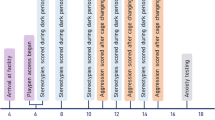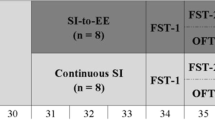Abstract
The aim of the study was to investigate the effects of rat housing conditions—standard conditions, social isolation, environmental enrichment—and the subsequent reversal of these conditions on the vulnerability of the gastric mucosa to ulcerogenic stimuli, somatic pain sensitivity, and treadmill work capacity. Rats, aged 30 days, were placed in standard conditions (SC), social isolation (Is), and environmental enrichment (EE) for 4 weeks. Then half of each group underwent a reversal of housing conditions: SC rats were moved to Is, Is rats were placed in EE, EE rats were moved to Is, for 2 weeks. The other half served as a control with no change in their initial housing. Two weeks after the reversal, vulnerability of the gastric mucosa to ulcerogenic action of indomethacin (IM, 35 mg/kg, sc), somatic pain sensitivity (hot plate test), and work capacity (measured by the running distance on a treadmill) were assessed in control and reversed groups. Social isolation induced a proulcerogenic effect, increasing IM-induced gastric erosions, which was effectively reversed when rats were transferred to an environmental enrichment. Conversely, transferring rats from an environmental enrichment to social isolation exacerbated ulcerogenic action of IM. Somatic pain sensitivity and treadmill work capacity were also influenced by housing conditions, with environmental enrichment showing positive effects. The present findings show that social isolation of rats induces a proulcerogenic effect. Environmental enrichment reverses proulcerogenic action of social isolation on the gastric mucosa and increases resilience to pain stimuli and treadmill work capacity.





Similar content being viewed by others
Data availability
The data that support the findings of this study are not openly available due to reasons of sensitivity and are available from the corresponding author upon reasonable request.
Abbreviations
- IM:
-
Indomethacin
- Is:
-
Isolation
- EE:
-
Environmental enrichment
- SC:
-
Standard conditions
- PLL:
-
Paw lick latency
References
Bannon S, Greenberg J, Mace RA, Locascio JJ, Vranceanu AM (2021) The role of social isolation in physical and emotional outcomes among patients with chronic pain. Gen Hosp Psychiatry 69:50–54. https://doi.org/10.1016/J.GENHOSPPSYCH.2021.01.009
Brown RE (2020) Donald O. Hebb and the Organization of Behavior: 17 years in the writing. Mol Brain. https://doi.org/10.1186/S13041-020-00567-8
Fang B, Yang S, Liu H, Zhang Y, Xu R, Chen G (2019) Association between depression and subsequent peptic ulcer occurrence among older people living alone: a prospective study investigating the role of change in social engagement. J Psychosom Res 122:94–103. https://doi.org/10.1016/J.JPSYCHORES.2019.04.002
Filaretova LP, Podvigina TT, Bobryshev PY, Bagaeva TR, Tanaka A, Takeuchi K (2006) Hypothalamic-pituitary-adrenocortical axis: the hidden gold in gastric mucosal homeostasis. Inflammopharmacology 14:207–213. https://doi.org/10.1007/s10787-006-1544-2
Gabriel AF, Paoletti G, Della SD, Panelli R, Marcus MAE, Farabollini F, Carli G, Joosten EAJ (2010) Enriched environment and the recovery from inflammatory pain: Social versus physical aspects and their interaction. Behav Brain Res 208:90–95. https://doi.org/10.1016/J.BBR.2009.11.015
Guven EB, Pranic NM, Unal G (2022) The differential effects of brief environmental enrichment following social isolation in rats. Cogn Affect Behav Neurosci 22:818–832. https://doi.org/10.3758/S13415-022-00989-Y
Le Bars D, Gozariu M, Cadden SW (2001) Animal models of nociception. Pharmacol Rev 53:597–652
Leemhuis E, Esposito RM, De Gennaro L, Pazzaglia M (2021) Go virtual to get real: virtual reality as a resource for spinal cord treatment. Int J Environ Res Public Health 18:1–10. https://doi.org/10.3390/IJERPH18041819
Mikocka-Walus A, Skvarc D, de Acosta MB, Evertsz FB, Bernstein CN, Burisch J, Ferreira N, Gearry RB, Graff LA, Jedel S, Mokrowiecka A, Stengel A, Trindade IA, van Tilburg MAL, Knowles SR (2022) Exploring the relationship between self-Isolation and distress among people with gastrointestinal disorders during the COVID-19 pandemic. J Clin Psychol Med Settings 29:654–665. https://doi.org/10.1007/S10880-021-09818-9
Normann MC, Cox M, Akinbo OI, Watanasriyakul WT, Kovalev D, Ciosek S, Miller T, Grippo AJ (2021) Differential paraventricular nucleus activation and behavioral responses to social isolation in prairie voles following environmental enrichment with and without physical exercise. Soc Neurosci 16:375–390. https://doi.org/10.1080/17470919.2021.1926320
Nuhu JM, Maharaj SS (2018) Influence of a mini-trampoline rebound exercise program on insulin resistance, lipid profile and central obesity in individuals with type 2 diabetes. J Sports Med Phys Fitness. https://doi.org/10.23736/S0022-4707.17.07120-1
Wang Y, Wei J, Guan X, Zhang Y, Zhang Y, Zhang N, Mao M, Du W, Ren Y, Shen H, Liu P (2020) Music intervention in pain relief of cardiovascular patients in cardiac procedures: a systematic review and meta-analysis. Pain Med 21:3055–3065. https://doi.org/10.1093/PM/PNAA148
**ong Y, Hong H, Liu C, Zhang YQ (2023) Social isolation and the brain: effects and mechanisms. Mol Psychiatry 28:191–201. https://doi.org/10.1038/S41380-022-01835-W
Yarushkina NI, Komkova OP, Filaretova LP (2020) Influence of forced treadmill and voluntary wheel running on the sensitivity of gastric mucosa to ulcerogenic stimuli in male rats. J Physiol Pharmacol. https://doi.org/10.26402/JPP.2020.6.04
Zhang P, Yan J, Wei J, Li Y, Sun C (2024) Disrupted synaptic homeostasis and partial occlusion of associative long-term potentiation in the human cortex during social isolation. J Affect Disord 344:207–218. https://doi.org/10.1016/J.JAD.2023.10.080
Acknowledgements
The study was supported by the Ministry of Education and Science of the Russian Federation (agreement No. 075-15-2020-921 for the creation and development of the world-class scientific center “Pavlov Center “Integrative Physiology—to medicine, high-tech healthcare and technologies of stress resistance”).
Funding
The study was supported by the Ministry of Science and Higher Education of the Russian Federation (agreement No. 075-15-2022-303/ 21.04.2022) for the creation and development of the world-class scientific center “Pavlov Center “Integrative Physiology—to medicine, high-tech healthcare and technologies of stress resistance”.
Author information
Authors and Affiliations
Contributions
All authors contributed to the study conception and design. Material preparation, data collection, and analysis were performed by Natalia Yarushkina, Olga Komkova, Olga Morozova, and Polina Punina. The first draft of the manuscript was written by Ludmila Flaretova and Natalia Yarushkina and all authors commented on previous versions of the manuscript. All authors read and approved the final manuscript.
Corresponding author
Ethics declarations
Conflict of interest
The authors declare that there were no conflicts of interest.
Ethical approval
The experimental procedures were approved by the Animal Care and Use Committee at the Pavlov Institute of Physiology (Animal Welfare Assurance #A5952-01). Protocols were designed in accordance with the National Institutes of Health Guidelines for the Care and Use of Laboratory Animals and complied with the International Association for the Study of Pain guidelines on the use of laboratory animals.
Statement on welfare of the animals
This study was done according to the international principles and regulations on animal welfare and use.
Consent for publication
Not applicable.
Additional information
Publisher's Note
Springer Nature remains neutral with regard to jurisdictional claims in published maps and institutional affiliations.
Rights and permissions
Springer Nature or its licensor (e.g. a society or other partner) holds exclusive rights to this article under a publishing agreement with the author(s) or other rightsholder(s); author self-archiving of the accepted manuscript version of this article is solely governed by the terms of such publishing agreement and applicable law.
About this article
Cite this article
Filaretova, L.P., Komkova, O.P., Morozova, O.Y. et al. Environmental enrichment reverses proulcerogenic action of social isolation on the gastric mucosa and positively influences pain sensitivity and work capacity. Inflammopharmacol 32, 909–915 (2024). https://doi.org/10.1007/s10787-024-01451-w
Received:
Accepted:
Published:
Issue Date:
DOI: https://doi.org/10.1007/s10787-024-01451-w




